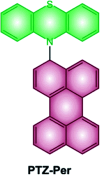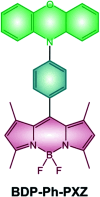Design of BODIPY dyes as triplet photosensitizers: electronic properties tailored for solar energy conversion, photoredox catalysis and photodynamic therapy
- PMID: 34040736
- PMCID: PMC8132938
- DOI: 10.1039/d1sc00732g
Design of BODIPY dyes as triplet photosensitizers: electronic properties tailored for solar energy conversion, photoredox catalysis and photodynamic therapy
Abstract
BODIPYs are renowned fluorescent dyes with strong and tunable absorption in the visible region, high thermal and photo-stability and exceptional fluorescence quantum yields. Transition metal complexes are the most commonly used triplet photosensitisers, but, recently, the use of organic dyes has emerged as a viable and more sustainable alternative. By proper design, BODIPY dyes have been turned from highly fluorescent labels into efficient triplet photosensitizers with strong absorption in the visible region (from green to orange). In this perspective, we report three design strategies: (i) halogenation of the dye skeleton, (ii) donor-acceptor dyads and (iii) BODIPY dimers. We compare pros and cons of these approaches in terms of optical and electrochemical properties and synthetic viability. The potential applications of these systems span from energy conversion to medicine and key examples are presented.
This journal is © The Royal Society of Chemistry.
Conflict of interest statement
There are no conflicts to declare.
Figures


























References
-
- El-Khouly M. E. Fukuzumi S. D'Souza F. ChemPhysChem. 2014;15:30–47. - PubMed
-
- Niu L. Y. Li H. Feng L. Guan Y. S. Chen Y. Z. Duan C. F. Wu L. Z. Guan Y. F. Tung C. H. Yang Q. Z. Anal. Chim. Acta. 2013;775:93–99. - PubMed
-
- Kowada T. Kikuchi K. Chem. Soc. Rev. 2015:4953–4972. - PubMed
-
- Nepomnyashchii A. B. Bard A. J. Acc. Chem. Res. 2012;45:1844–1853. - PubMed
Publication types
LinkOut - more resources
Full Text Sources
Other Literature Sources
Miscellaneous

